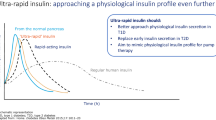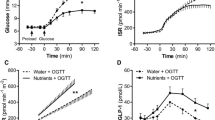Summary
Individuals with insulin-dependent diabetes mellitus (IDDM or type 1 diabetes) are deficient in both insulin and amylin, peptides secreted by the beta cell. We have investigated the effects of amylin replacement therapy employing the human amylin analogue, pramlintide (25, 28, 29-pro-human amylin, previously referred to as AC137), upon the responses to a standardized insulin infusion (40 mU · kg−1 · h−1) for 100 min and a liquid Sustacal meal (360 kcal) in 84 healthy IDDM patients. Following baseline evaluations, patients were randomly assigned to receive subcutaneous injections of placebo, 30, 100 or 300 Μg pramlintide 30 min before meals for 14 days. There was no meaningful difference between adverse events reported by the 30-Μg pramlintide and the placebo groups, but ten subjects withdrew due to nausea, eight of these in the 300-Μg dose group. Peak plasma pramlintide concentrations for the 30-Μg group were 21±3 and 29±5 pmol/l on Days 1 and 14, respectively. These values are similar to postprandial plasma amylin concentrations in normal volunteers. The plasma glucose, free insulin, glucagon, epinephrine and norepinephrine concentrations during the insulin infusion test before and after therapy were identical in each of the groups. Prior to pramlintide therapy, Sustacal ingestion produced a 4.0–4.8 mmol/l rise in plasma glucose concentrations in each of the groups. Pramlintide therapy reduced postprandial hyperglycaemia as reflected by the 3-h incremental AUCglucose (AUCglucose above or below fasting glucose concentration) Day 1 vs Day 14: 30 Μg, 322±92 vs −38±161 mmol/l · min, p=0.010; 100 Μg, 317±92 vs −39±76 mmol/l · min, p=0.001; and 300 Μg, 268±96 vs −245±189 mmol/l · min, p=0.077. Thus, pramlintide therapy with these regimens did not appear to impair either in vivo insulin action or the counter-regulatory response to hypoglycaemia but did show a clear effect of blunting postprandial hyperglycaemia following a standardized meal.
Similar content being viewed by others
Abbreviations
- IDDM:
-
Insulin-dependent diabetes mellitus
- AUCglucose :
-
area under the plasma glucose concentration curve
- ANOVA:
-
analysis of variance
References
Cooper GJS, Willis AC, Clark A et al. (1987) Purification and characterization of a peptide from amyloid-rich pancreases of type 2 diabetic patients. Proc Natl Acad Sci USA 84: 8628–8632
Westermark P, Wernstedt C, Wilander E, Sletten K (1986) A novel peptide in the calcitonin gene related peptide family as an amyloid fibril protein in the endocrine pancreas. Biochem Biophys Res Commun 140: 827–831
Nishi M, Sanke T, Seino S et al. (1989) Human islet amyloid polypeptide gene: complete nucleotide sequence, chromosomal localization, and evolutionary history. Mol Endocrinol 3 (11): 1775–1781
Hartter E, Svoboda T, Ludvik B et al. (1991) Basal and stimulated plasma levels of pancreatic amylin indicate its co-secretion with insulin in humans. Diabetologia 34: 52–54
Butler PC, Chou J, Carter B, Wang YN et al. (1990) Effects of meal ingestion on plasma amylin concentrations in NIDDM and nondiabetic humans. Diabetes 39: 752–756
Mitsukawa T, Takemura J, Asai J et al. (1990) Islet amyloid polypeptide response to glucose, insulin, and somatostatin analogue administration. Diabetes 39: 639–642
Kahn SE, Fujimoto WY, D'Alessio DA, Ensinck JW, Porte D (1991) Glucose stimulates and potentiates islet amyloid polypeptide secretion by the B-cell. Horm Metab Res 23: 577–580
Akimoto K, Nakazato M, Matsukura S, Hayakawa K (1993) Plasma concentration of islet amyloid polypeptide in healthy children and patients with insulin-dependent diabetes-mellitus. Acta Paediatr 82: 310–311
Koda JE, Fineman M, Rink TJ, Dailey GE, Muchmore DB, Linarelli LG (1992) Amylin concentrations and glucose control. Lancet 339: 1179–1180
Blackard WG, Clore JN, Kellum JM (1994) Amylin/insulin secretory ratios in morbidly obese man: inverse relationship with glucose disappearance rate. J Clin Endocrinol Metab 78: 1257–1260
Cooper GJS, Leighton B, Dimitriadis GD et al. (1988) Amylin found in amyloid deposits in human type 2 diabetes mellitus may be a hormone that regulates glycogen metabolism in skeletal muscle. Proc Natl Acad Sci USA 85: 7763–7766
Young AA (1994) Amylin regulation of fuel metabolism. J Cell Biochem 55 [Suppl]: 12–18
Brown K, Menius A, Sandefer E, Edwards J, James M (1994) The effects of amylin on changes in plasma glucose and gastric emptying following an oral glucose load in conscious dogs. Diabetes 43 [Suppl 1]: 172A (Abstract)
Young AA, Gedulin B, Vine W, Percy A, Rink TJ (1995) Gastric emptying is accelerated in diabetic BB rats and is slowed by subcutaneous injections of amylin. Diabetologia 38: 642–648
Kolterman O, Gottlieb A, Moyses C, Colburn W (1995) Reduction of post-prandial hyperglycaemia in subjects with type 1 diabetes mellitus by intravenous infusion of pramlintide, a human amylin analogue. Diabetes Care 18: 1179–1182
National Diabetes Data Group (1979) Classification and diagnosis of diabetes mellitus and other categories of glucose intolerance. Diabetes 28: 1039–1057
White NH, Skor DA, Cryer PE, Levandoski LA, Bier DM, Santiago JV (1983) Identification of type I diabetic patients at increased risk for hypoglycaemia during intensive therapy. N Engl J Med 308: 485–491
Butler PC, Chou J, Carter B et al. (1990) Effects of meal ingestion on plasma amylin concentration in NIDDM and nondiabetic humans. Diabetes 39: 752–756
Brenner W, Hendrix TR, McHugh PR (1983) Regulation of the gastric emptying of glucose. Gastroenterology 85: 76–82
Horowitz M, Fraser R (1994) Disordered gastric motor function in diabetes mellitus. Diabetologia 37: 543–551
Mosberg S, Carlberger G (1974) Gastric emptying in healthy subjects and patients with various malabsorptive states. Scand J Gastroenterol 9: 17–21
Pehling G, Tessari P, Gerich JE, Haymond MW, Service FJ, Rizza RA (1984) Abnormal meal carbohydrate disposition in insulin-dependent diabetes. Relative contributions of endogenous glucose production and initial splanchnic uptake and effect of intensive insulin therapy. J Clin Invest 74: 985–991
Fraser RJ, Horowitz M, Maddox AF, Harding PE, Chatterton BE, Dent J (1990) Hyperglycaemia slows gastric emptying in type 1 (insulin-dependent) diabetes mellitus. Diabetologia 33: 675–680
MacGregor IL, Gueller R, Watts HD, Meyer JH (1976) The effect of acute hyperglycaemia on gastric emptying in man. Gastroenterology 70: 190–196
Keshavarzian A, Iber FL, Vaeth J (1987) Gastric emptying in patients with insulin requiring diabetes mellitus. Am J Gastroenterol 82: 29–35
Nowak TV, Roza AN, Weisbruch JP, Brosnan MR (1994) Accelerated gastric emptying in diabetic rodents: effect of insulin treatment and pancreas transplantation. J Lab Clin Med 123: 110–116
Ghatei MA, Datta HK, Zaidi M et al. (1990) Amylin and amylin-amide lack an acute effect on blood glucose and insulin. J Endocrinol 124: R9-R11
Nyholm B, Moller N, Bryan G, Moyses C, Alberti KGMM (1995) Acute metabolic effects of the amylin analogue AC-0137 in patients with insulin-dependent diabetes mellitus. Diabetologia 38:A193 (Abstract)
Author information
Authors and Affiliations
Rights and permissions
About this article
Cite this article
Kolterman, O.G., Schwartz, S., Corder, C. et al. Effect of 14 days' subcutaneous administration of the human amylin analogue, pramlintide (AC137), on an intravenous insulin challenge and response to a standard liquid meal in patients with IDDM. Diabetologia 39, 492–499 (1996). https://doi.org/10.1007/BF00400683
Received:
Revised:
Issue Date:
DOI: https://doi.org/10.1007/BF00400683




